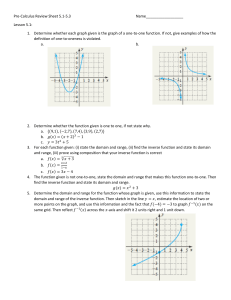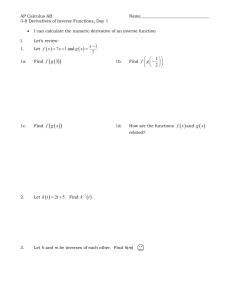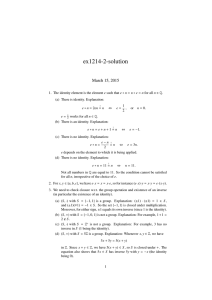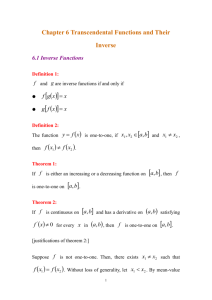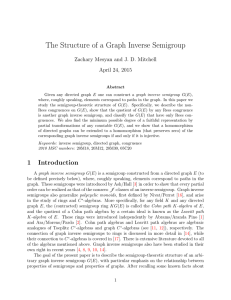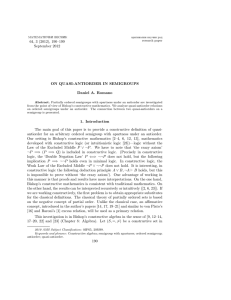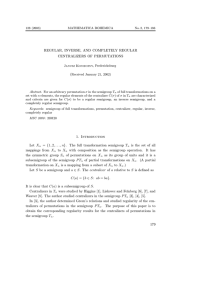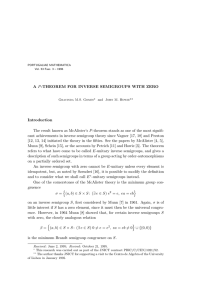D’ALARCAO’S A SIMPLIFICATION OF IDEMPOTENT SEPARATING EXTENSIONS OF INVERSE
advertisement
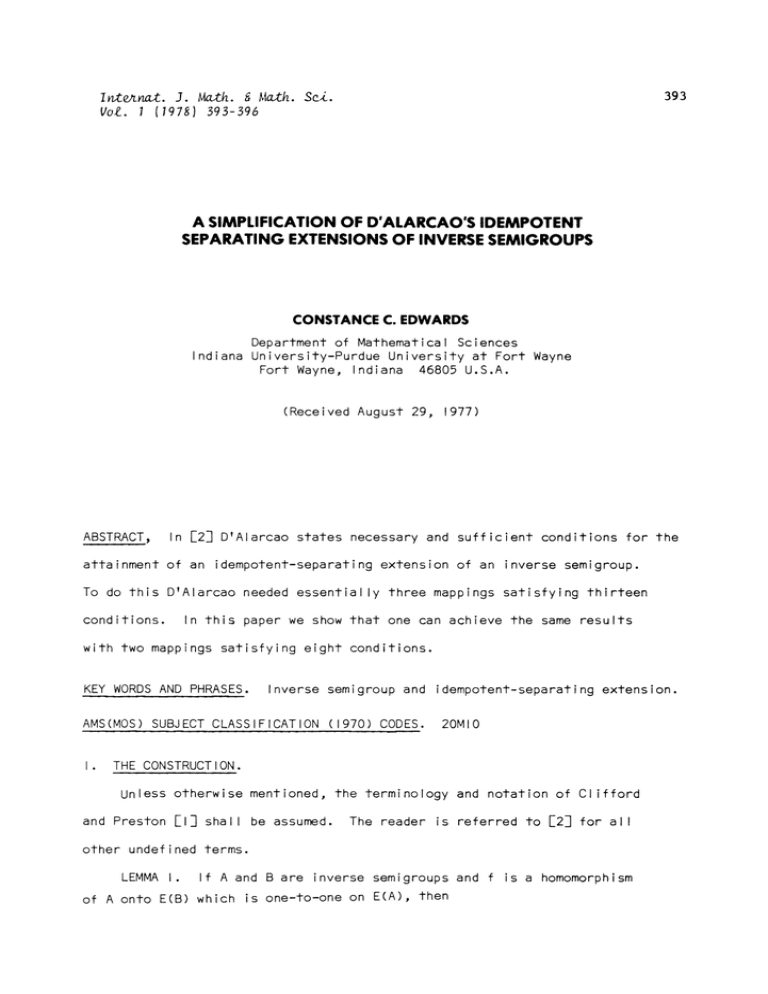
I ntrnat. J. Math. & Math. Sci.
Vol.
393
(1978)393-396
A SIMPLIFICATION OF D’ALARCAO’S IDEMPOTENT
SEPARATING EXTENSIONS OF INVERSE SEMIGROUP$
CONSTANCE C. EDWARDS
Department of Mathematical Sciences
Indiana University-Purdue University at Fort Wayne
Fort Wayne, Indiana 46805 U.S.A.
(Received
ABSTRACT,
August 29,
1977)
In [2] D’Alarcao states necessary and sufficient conditions for the
attainment of an idempotent-separating extension of an inverse semigroup.
To do this D’Alarcao needed essential y three mappings satisfying thirteen
conditions.
In this paper we show that one can achieve the same results
with two mappings satisfying eight conditions.
KEY WORDS AND PHRASES.
Inverse semigroup and idempotent-separating extension.
AMS(MOS) SUBJECT CLASSIFICATION (1970) CODES.
20MIO
THE CONSTRUCT ION.
Unless otherwise mentioned, the terminology and notation of Clifford
and Preston
[I] shall
be assumed.
The reader is referred to
[2] for all
other undefined terms.
LEMMA I. If A and B are inverse semi groups and f is a homomorphism
of A onto E(B) which is one-to-one on E(A), then
C.C. EDWARDS
394
(i)
(i i)
(i
i)
(a -I a)f for all a
af
a
-I ga
ga
-I a for all a
A and g
A and g
ag for all a
ga
A;
E(A); and
E(A).
E(B), by Lallement’s result [3], there exists
-I
-I
-I
-I
(af)
(ef)
e f
a f,
e s E(A) such that af
ef. Consequently, ef
-I
(a -I a)f.
(a f)(af)
and thus af
ef
PROOF.
(i i)
((ga)
-I
Since af
(i)
By part (i), for each g
(ga)f
ga)f
gf
(iii)
-I
(ga) ga
By part (ii), ga
the proof of the
-I
(a a)f
gf
af
-I
one on E(A), we have a ga
a(a
A,
-I
(ga a)f.
E(A) and a s
Since f is one-to-
-I
ga a.
-I ga)
a(ga
-I a)
ag.
This completes
emma.
Let A and B be inverse semigroups and let f be a homomorphism of
A onto E(B) which is one-to-one on E(A).
(The existence of such an f
implies that A is a semi lattice of groups; see e.g. [4].)
is a mapping w of B x B into A (denoted by (b,c)w
each b
B there is a mapping U
(PI)
For each b, c
(P2)
For each b
(P3)
If b, c
(P4)
(bc)d(b c) d
(P5)
If b
(P6)
For each b s
(P7)
bC(a b
c
B, b
LeT S*
{(b,a)-b
a
b
b
B, U b is a homomorphism.
B and a
bCdc d
Ib)f
(b
then a
for all b, c, d
c
(c- b-
bc)f
-I
B.
b
E(A)#I bf
ea where {e}
A, then a
b
E(A)/I (b -I b)f -I
e where {e}
B, (bb -I
E(B) and a
c
a
E(A)
such that"
(c-lb-lbc)f-l.
bCbC
for all a s A and b, c
(PS) For each b, c s E(B), b
{g}
b c) and that for
of A into A (denoted by aU
b
Suppose there
F
cf
c
eg where {e}
I.
B.
E(A) #I bf
-I and
-I.
B and a
(b
-I b)f}.
Let equality in S* be defined in the
usual manner and let multiplication be defined by
(b,a)(c,p)
(bc,bCa cp).
EXTENSIONS OF INVERSE SEMI GROUPS
Moreover, let y’S*- B be defined by (b,a)y
b.
Under the above conditions, (S*,y) is an idempotentoseparating
THEOREM I.
extension of A by B.
Moreover,
Note that since
PROOF.
395
YIA
fof-I
f.
is idempotent separating,
(b
E(A) and e, a
Consequently, if e
-I b)f -I
then ea
fof-I
.
ae.
a
As is shown in [2, closure in S* fol lows from (PI) and (p3) and,
associativity follows from (P2), (P4) and (P7).
Our proof that S* is regular is the same as that found in [2 but
Let (b,a) e S* and let x
is more informative.
(PI) and (P3),
(b-’ ,x)
(P3),
e S* since xf
(b b-I b-lx)b
(b b-I b-J Ib
x
(b,a)(b
{e}
-I
a
i’
As shown in
A*
E(A)II cf
ga
gf-I.
since
(b b-I b-lx?b
we
a
Let 6"A*
Then a
By (P8)
p)
Consider the subset A*
A by (b,a)
/
ea and p
+
(bc, ea
is one-to-one.
gp where {e}
gp)
(bc, ap).
{(b,a)-b
E(A)
(b,a)(c,P)
Thus
e E(B)}
bf
(bc ,b
-I and
c aCp)
is a homomorphism
It fol lows from the definitions of
Consequently the
A* is isomorphic to the inverse semi group A.
an inverse semigroup.
E(S*) then
c_
S*
To show 6 is a homomorphism,
a.
(P5) and lemma liii
which obviously has A for its range.
S* and 8 that
Also, by (P I) and
it follows from (P5) and (P6) that if (g,e)
E(A)
let (b,a), (c p)
(bc, eg
-’
b(bb-I b-lxbal
(
which contains E(S*).
{g}
bb
It now fol lows from (P6) that
a.
[2,
E(B) and {e}
g
Since
f
a
(b,ea)= (b,a) since
b,(bb -I)
(b-lb)f -I Consequently, S* is regular
,x)(b,a)
E(A)
b
b.
Consequently
f.
b
(Cab-’-’ b-l) -’)
b-
f
a
a
have
bb-
f
a
By
a
dempotents of S* commute
We now have that S* is
C.C. EDWARDS
396
It is obvious that y is a homomorphism of S* onto B and {E(B)}y -I
E(A*) such that (b,a)y
If (b,a), (c,p)
Since a, p
E(A), a
obvious that Y
2.
p.
IA,= f"
(c,p)y, then b
c and af
Consequently y is one-to-one on E(A*).
Since A*
A*.
b
It is
A, this completes the proof of the theorem.
THE STRUCTURE THEOREM.
Since our two mappings and eight properties are the same as, but fewer
than, those used by D’Alarcao, the following theorem has been proven by
D’Alarcao ([2], Theorem 2).
THEOREM 2.
Let A and B be inverse semi groups and let (S,f) be an
idempotentoseparating extension of A by B.
exists a mapping U
Then for each b
of A into A (denoted by aU
b
b
a
b
B there
and there exists
a mapping w of B x B into A satisfying (PI) through (P8).
Moreover,
S is isomorphic to S*.
REFERENCES
I.
Clifford, A. H. and G. B. Preston
2.
D’Alarcao, H.
3.
Lal ement, G.
The Alcebraic Theory of Semigroups,
Vol. I, Math Surveys of the American Math. Soc. 7 (Providence, R I,
1961 ).
Idempotent-Separating Extensions of Inverse Semigroups,
J. Aust. Math. Soc. 9 (1969) 211-17.
Congruences et Equivalences de Green sur un Demi-groupe
Paris Ser A 262 (1966) 613-6.
R@gulier, C. R. Acad. Sc.
4.
Preston, G. B. Inverse Semi-groups, J. of the London Math. Soc.
29 (1954) 396-403.
c
pf.


